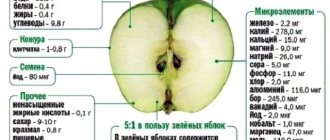What foods should be introduced at 7-8 months
Feeding a baby at 7 months
add egg yolk and increase the volume of fruit puree. At 8 months the range of products is even wider - look at the table:
| What and how much to add to complementary foods | At 7 months | At 8 months |
| Fruit puree, g | 70 | 80 |
| Yolk, pieces | ¼ (quail ½) | ½ (quail 1 piece) |
| Cottage cheese, g | 10→40 | 50 |
| Children's kefir or yogurt, biolact, ml | 0→200 | |
| Fish puree, g | 5→30 | |
| Juice, ml | 5→60 | |
| Wheat bread, crackers | ¼ – 1/6 piece of bread (5 g) | |
| Compote of fresh fruits or dried fruits, ml | 5→60 | |
| Children's tea, ml | 5→60 |
Introduce new products in the same way as before:
- The first time - no more than 1 teaspoon, yolk - ¼ piece. To a hungry child in the morning.
- Every day - a spoonful more.
- After complementary feeding, offer breast or formula.
- After 7 or 10 days you will reach the desired volume - in the table.
- After 14 days - a new type of complementary food1.
Norms and products
The baby's menu at seven to eight months depends on when complementary feeding begins and the characteristics of his body.
The diet of babies at this age may include:
- vegetable puree – no more than 150 g;
- porridge – no more than 150 g;
- pureed fruits – no more than 60 g;
- yolk – no more than a quarter;
- cottage cheese – up to 40 g;
- crackers or bread;
- vegetable oil and butter – no more than 3.5 g.
These are the maximum standards; you don’t need to give your baby more than this amount. Most babies, especially infants, do not need such abundant complementary feeding. Complementary feeding at 7-8 months can be reduced only to porridge or pureed vegetables. Fermented milk products and fruits may appear on the children's menu a little later.
Vegetables
What should I give my 7 month old baby as complementary vegetable food? The main rule for preparing vegetable puree for a baby of this age is that the product is single-component and hypoallergenic.
Suitable for purees:
- zucchini;
- cauliflower and broccoli;
- pumpkin;
- carrot.
If the baby absorbs complementary foods well, then with the permission of the pediatrician, you can try introducing mashed potatoes. Potatoes are a high-calorie vegetable and are more difficult to digest than the listed products. If any body reactions occur, its administration should be postponed for a month.
The eighth month of a baby’s life implies a complete ban on the use of salt when preparing complementary foods from vegetables.
Porridge
Preference should be given to rice, buckwheat and corn porridges. They rarely cause allergies and are easily digestible. If your child is not prone to allergies, you can try oatmeal porridge, and a little later - multigrain porridge. But it’s better to wait up to a year with pearl barley, semolina and wheat cereals.
You can prepare porridge from cereals yourself, after sorting, washing and chopping them. You can use ready-made baby cereals in boxes. Sugar and salt cannot be added. To improve the taste of the finished dish, you can add a drop of butter, breast milk or a little adapted mixture.
Fruits
The baby's menu at 7 months includes fruit puree, which can be made from apples, pears, bananas, peaches and apricots. The safest fruit for a baby is an apple. This is where it is recommended to start introducing a child to fruits. The fruits are steamed or stewed in a small amount of water, after which they are crushed with a blender.
Cottage cheese
After 7 months, it is recommended to introduce cottage cheese into the baby’s diet to provide his body with calcium. If a 7-month-old child does not want to eat complementary foods in the form of cottage cheese, that’s okay. This product may be introduced much later. Its daily norm should not exceed 40 grams.
Meat and fish
At seven months the baby can be given meat. The main rule is that the product must be freshly prepared, of high quality and low-fat. The meat is boiled, thoroughly chopped and added to soup or vegetable puree. Turkey, rabbit, veal and chicken are ideal for baby food. Meat can be given twice a week. It is better to postpone the baby’s acquaintance with fish for a few more months.
Yolk
Quail yolk is preferable for baby nutrition, since it causes allergic reactions less often than chicken yolk. Complementary feeding begins with a few grains, gradually increasing the serving size to half a chicken or one quail yolk. It is recommended to give it twice a week in the morning feeding, mixing with porridge, puree or milk.
Salt, sugar and vegetable oil
After 6 months, it is necessary to introduce healthy and necessary vegetable oils (olive, sunflower) into the baby’s diet. You should start with a few drops, gradually increasing the daily serving to 1 teaspoon.
Children under 12 months are not recommended to add salt or sugar to their food. Butter and vegetable oils act as flavor enhancers for babies.
If a child at 7 months does not eat complementary foods without sugar, then with the permission of the pediatrician, you can try to improve the taste of food with sugar syrup. To prepare it, add sugar to water in a 1:1 ratio and boil for 20 minutes.
Juices and compotes
The menu of a 7-month-old child is allowed to be varied with fruit compotes and juices. Mom can cook them herself or buy ready-made industrial products. To prepare drinks, you need to use fruits that do not contain pesticides and nitrates. If you are not so sure, it is better to buy industrially produced juices. At 7 months, preference should be given to single-component juices: apple, carrot, pear, pumpkin, peach.
Complementary feeding at 7 months while breastfeeding
If the child is breastfed, then you can diversify his diet from six months. This is how the baby gets acquainted with regular food. Complementary feeding at 7 months during breastfeeding involves certain foods and the specifics of their introduction.
Table of contents
|
Introduction of complementary foods from 7 months: reasons
Infants begin to be given additional products from six months of age. Sometimes the introduction of complementary foods has to be delayed for a month or even longer.
The reasons for this may be the following:
• Disease. It is not recommended to introduce your baby to something new when he is sick or teething.
• Mixed feeding. If you breastfeed exclusively, the enzymatic system matures by 6 months of age.
If an artificial mixture was additionally used at this time, the process takes longer.
• Weakened body. This is often due to the peculiarities of the birth of a child - caesarean section, complications during childbirth.
In the presence of such factors, the introduction of new products is postponed for a month (sometimes more), so the diet becomes more varied only at seven months of age.
Rules for introducing complementary foods at 7 months
Familiarity with different products is very important. It needs to be organized so that the baby can comfortably change his eating habits.
To do this, it is important to comply with the following rules:
• Breast milk remains the main source of nutrition.
• Administer additional nutrition in small portions. It should be offered to the child before breastfeeding, although some experts have a completely opposite opinion.
It is better to give purees and fruit juices after the main feeding, since after sweets the baby may refuse the main food.
• For early complementary feeding, it is better to use products that the woman has already consumed while breastfeeding. The child is already indirectly familiar with them.
• Feed with a spoon, but a non-metal one.
The use of cutlery is necessary for the development of chewing and swallowing skills.
• Any new product is included in the diet with a minimum amount - half a teaspoon is enough for the first try.
This volume should be gradually increased, bringing it up to the age norm.
• New foods should be introduced one at a time. It is allowed to mix a new product with previously tested products.
• Monitor reactions closely.
A new product may cause allergies or stomach upset. To better observe the baby’s reaction, new items should be introduced before lunch.
• You cannot force feed a child. This will greatly complicate the process of introducing new foods.
• Salt, sugar, spices are prohibited.
Permitted products, their norm
There are two types of complementary feeding - pediatric and pedagogical.
The first implies products that are approved by age and correspond to the norm in quantity.
The pedagogical option means that the baby receives a variety of foods that are present on the menu of other family members, but in small quantities.
Products allowed at seven months of age are reflected in the following complementary feeding table:
| Type of complementary foods | Eligible Products | Daily consumption rate |
| Porridge | Buckwheat, rice, corn. If such food is well tolerated, then rolled oats porridge is acceptable | 100 g |
| Vegetable purees, soups | Broccoli, cauliflower, zucchini, potatoes. In the absence of allergies, the diet can be varied with carrots, pumpkin and greens | 150 g |
| Fruit puree, juice, compote | Apples, pears, apricots, peaches, dried fruits. Only bananas are exotic | 150 g |
| Dairy, fermented milk products | Yogurt, low-fat cottage cheese, children's kefir. Additives and flavorings are prohibited | 30-50 g cottage cheese, 150 g kefir, yogurt |
| Eggs | Boiled yolk only | Quarter yolk |
| Oil | Vegetable, creamy | 5 g |
If new items were introduced earlier than six months, then by the age of seven months the baby’s diet can be enriched with meat.
At this stage, you should limit yourself to lean boiled beef, veal, and rabbit.
Poultry - turkey, chicken - is also allowed. You can eat up to 30 g of meat per day.
There are other opinions regarding products acceptable for a seven-month-old baby. Dr. Komarovsky believes that kefir and yogurt should be introduced no earlier than 9 months.
Menu for a 7 month old baby
The list of permitted products does not mean that you need to consume them every day. Every day you can eat porridge, vegetable puree, and drink juice.
Fermented milk products can be consumed up to 2-3 times a week (for each item), and meat and yolk - 2 times.
An approximate menu for a week for a 7-month-old baby could be as follows:
| Time/Day of week | 6 a.m | 10 a.m | 2 pm | 6 p.m | 10 pm |
| Mon | Breast milk (about 200 ml) | Buckwheat | Broccoli and meat puree | Applesauce, yogurt | Breast milk (about 200 ml) |
| W | Breast milk (about 200 ml) | Rice porrige | Chicken broth soup with broccoli | Apricot puree, baby kefir | Breast milk (about 200 ml) |
| Wed | Breast milk (about 200 ml) | Corn porridge | Cauliflower and meat puree | Cottage cheese, juice | Breast milk (about 200 ml) |
| Thu | Breast milk (about 200 ml) | Rice-buckwheat porridge | Zucchini and carrot soup | Pear puree, baby kefir | Breast milk (about 200 ml) |
| Fri | Breast milk (about 200 ml) | Oatmeal | Pumpkin puree | Peach puree, compote | Breast milk (about 200 ml) |
| Sat | Breast milk (about 200 ml) | Buckwheat | Chicken broth soup with potatoes | Banana puree, yogurt | Breast milk (about 200 ml) |
| Sun | Breast milk (about 200 ml) | Corn porridge | Broccoli puree | Cottage cheese, juice | Breast milk (about 200 ml) |
Each feeding also includes breast milk, which at this age remains the main source of food for the baby.
Useful tips for mothers: BABY UP TO ONE YEAR
Meat can be given separately (chopped), but children often do not like it, so it is better to use a mixture with vegetables.
A child does not eat solid foods well at 7 months: reasons
Not all children are ready to try new things. A child may refuse to try a new product for the following reasons:
• don’t like the taste – almost all people have unfavorite dishes;
• incorrect consistency of the dish;
• too much food;
• force feeding;
• physiological and psychological unpreparedness for adult food.
Ready-made complementary foods and homemade food
The subject of dispute is often the question of what is better – ready-made products or a home-cooked dish.
In the first case, strict requirements are imposed on manufacturers - for the production of baby cereals, juices and purees, high-quality raw materials are used, which are carefully processed and processed.
Cooking your own food allows you to mix different foods. You should choose the appropriate option yourself.
If you choose to independently prepare complementary foods for a 7-month-old baby, it is important to remember the following rules:
• Use only recycled meat broth. Boil the meat for 10 minutes, then change the water and continue cooking.
• The meat is first boiled and then minced.
• Cottage cheese can be diluted with breast milk. You can use kefir instead of milk.
• For pureeing, vegetables are thoroughly cleaned, then finely chopped, stewed or boiled.
• Cereals are thoroughly washed and crushed before cooking.
At first they are boiled only in water, and for taste you can add breast milk and chopped fruits (allowed and already familiar).
The introduction of complementary foods allows you to introduce your baby to adult foods. Any new products must be introduced gradually, observing quantitative standards.
If you have an allergy or other negative reaction of the body to any dish, this is not the time to avoid it.
Svetlana Ovechkina
TEACHER Higher pedagogical education. Director of the kindergarten.











